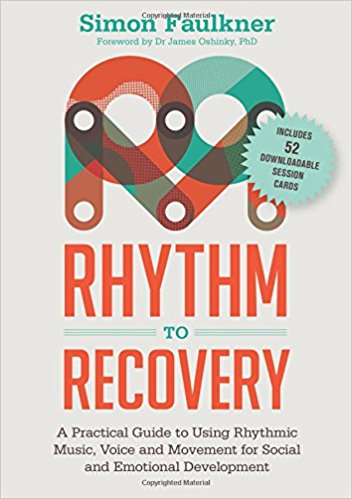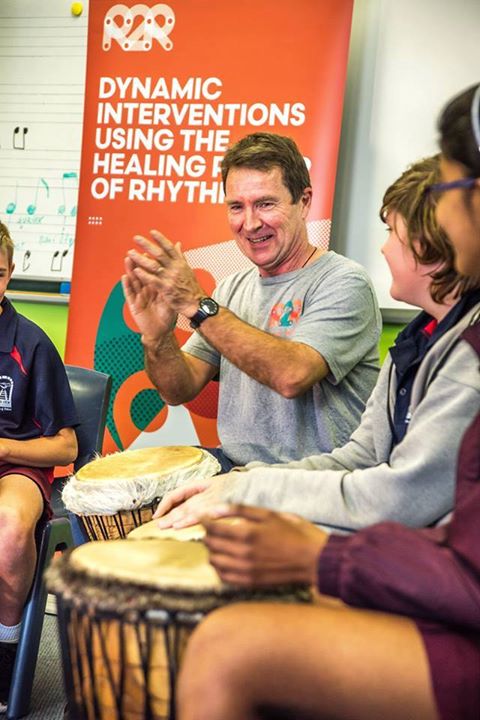Faulkner, S.: Rhythm to Recover – A Practical Guide to Using Rhythmic Music, Voice and Movement for Social and Emotional Development, published by Jessica Kingsley Publishers (2017)
(This review first appeared in The Studio (May 2017), published by MTA of NSW.)
Simon Faulkner has become one of the world’s leading exponents on the use of drumming for purposes other than performance. He has taken the primal, tribal and tactile elements of the art of drumming and applied them to heal and motivate people of all ages. In healing, his objective is not to replace the medical or psychological practitioners, but rather work with clinics, schools, and a diverse array of other providers in calming the individual, grounding personalities, and developing improved socialisation skills.
 His Rhythm2Recovery method is powerful and transformative in the lives of those with whom it comes in contact. Hailed across the world, it is a methodology which everyone (regardless of musical experience) can use and enjoy. No prior musical experience is necessary for those wishing to utilise the techniques.
His Rhythm2Recovery method is powerful and transformative in the lives of those with whom it comes in contact. Hailed across the world, it is a methodology which everyone (regardless of musical experience) can use and enjoy. No prior musical experience is necessary for those wishing to utilise the techniques.
People who participate in the system learn such things as identity, group dynamics, behavioural limits, and risk-taking in a controlled environment.
Feedback in the Rhythm2Recovery workshops is immediate and friendly, thus providing participants understanding and directions for behavioural change.
The system debunks the notion that music is purely for experts, or for those for whom years of practice have been devoted. Instead, it asserts and affirms that everyone is musical, to some degree, and has the capacity to organise sound, participate in a group (no matter how disparate the members of the group) and use their bodies effectively in alignment with the musical rhythms.
Years of research by the author has given him the skills to use the language of rhythm to develop trust in individuals. He shows in the book how he uses his technique not only for musical outcomes, but more importantly to him, for therapeutic and social benefits.
Divided into two sections, the author has provided a readable work which states the theory, research and resources for his innovative and highly successful method, and then moves into a section outlining games, exercises and other applications.
 In the first section, he details specific groups of people and how to work his programme with them, including in the areas of early childhood, individuals with special needs, youth, mental health patients, alcohol and drug dependent individuals, trauma victims, veterans, parents, aged people, and even in prisons, corporate management and staff contexts.
In the first section, he details specific groups of people and how to work his programme with them, including in the areas of early childhood, individuals with special needs, youth, mental health patients, alcohol and drug dependent individuals, trauma victims, veterans, parents, aged people, and even in prisons, corporate management and staff contexts.
After reading the first part of the book which sets up the system with the research and theory, the second part reveals how to be hands-on with the approach, giving guidance on the delivery of highly accessible and rhythmic exercises in a sequential manner. Growing confidence in application, by using these initial patterns, will ensure the practitioner develops his or her improvisational skills, which ultimately leads to a feeling of empowerment.
The author deals with basic hand-drum technique, posture, WHS, as well as more specific knowledge, such as Bass and Tone, Flam and Slap, and Tablature, before breaking out into specific rhythmic patterns. There are games and exercises which could be used in a diverse range of activities (even by the school teacher).
Finally, there are five key points which summarise the findings: 1. Finding your base (or finding your place); 2. How these rhythms impact one’s life in developing better relationships; 3. The drum as your voice (and your heart); 4. The drum as a means of team building; and 5. The drumming system which provides a means to build community.
Rhythm2Recovery is a versatile system which elevates therapy from merely listening to the soothing tones of wonderful music, to the practical. It is engaging and motivating, and more importantly, empowering. Simon Faulkner is a convincing advocate for the use of rhythm in all our lives, bringing a much-needed equilibrium that most other systems rarely can offer.
